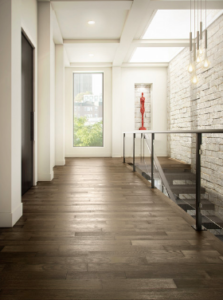Do Dark Hardwood Floors Make a Space Seem Smaller?
One of the most common fears of installing dark hardwood floors is that it may make spaces in your home seem smaller. While it is true that dark colors absorb light, it is possible to counteract this with your choice of décor. Our hardwood floor installation specialists are here to help you with planning your space, making sure your new hardwood flooring seamlessly meets your vision for any project. Here are a few things to consider while doing your own research on dark hardwood flooring:
Paint
Using a lighter shade of paint will open up your space to the eye and mitigate the impact of the dark flooring. Avoid using dark shades of paint unless you are planning on a lighter shade hardwood or other flooring material for your home. The one exception to this is a dark accent wall. Just a shade or two darker on one wall can trick the eye, making our brains think that wall is farther away. Gray paint is a very popular choice for this in home design today and has created great spaces paired with our selection of dark hardwood for past clients.
Lighting
Light fixtures and blinds are big players when it comes to the design and feel of your room. Natural lighting works beautifully with dark hardwood flooring by providing a perfect contrast. Go with shorter sheer blinds (or none at all) to bring light into the room. Pair this with a few fixtures or houseplants to bring that pop a room with darker floors often needs. Recessed lighting or pendant lights are also good when used in conjunction, or as alternatives, to natural lighting.
Rugs
A nice area rug with a lighter shade color scheme is a great way to give separation to the room. Make sure it does not cover the whole floor as its important to strike a balance between the floor, rug, and walls. Designer rugs have become favorite fixtures for modern home designers.
Furniture
Perhaps the biggest piece of the puzzle, furniture is the last step in completing your room. Glass is a fantastic accent for dark hardwood whether it be a coffee table, TV stand, or cabinet. It makes a big difference when compared to their wooden counterparts, and adds functionality with style.
Contact Us
Classic Floor Designs is proud to have worked on projects with clients such as The Four Seasons Hotel, the White House, The Erwin Gomez Salon & Spa, and the Baltimore Masonic Temple. We are confident in our ability to make your dream space come to life. Let us bring our 40+ years of experience right into your home today! Get started today and give us a call at (202) 872-9860 for a FREE consolation.




